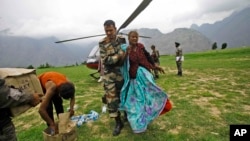NEW DELHI —
In North India, bad weather is hampering efforts to rescue tens of thousands of people stranded in a Himalayan state following flash floods. The death toll in the disaster has climbed to 560, but many people are still missing, raising fears that the toll will mount higher.
Heavy cloud, mist and intermittent rains hampered the operation to airlift people from the worst-hit areas in Uttarakhand state. Soldiers focused on restoring bridges and repairing access routes as they raced to bring survivors to safety amid forecasts of more downpours in the coming days.
Priests are being asked to begin mass cremation of the victims in the town of Kedarnath - a pilgrim spot that was among the worst hit areas.
It has been a week since heavy monsoon rains caused widespread devastation in the Himalayan region, washing away roads, bridges and entire villages.
About 80,000 people have been rescued so far. Many recounted distressing experiences of doing without food and shelter for days.
But thousands remain stranded, while an unknown number are missing. Relatives are desperately searching for family members.
V.K. Duggal, a senior official of the National Disaster Management Authority in New Delhi, denied charges of a slow response to the disaster.
“Really speaking there are no major gaps in coordination. And all agencies are doing their very best to make sure that the relief and rescue operations moves smoothly and at as good a speed as possible," Duggal said. "There may be some impediments of weather, this, that, but when you have a problem of this massive size, at the operational level, there will be some plusses and minuses.”
Many charities have rushed volunteers to the region to supplement the official rescue and relief operation. Among them is Save the Children, which has sent in a team to assist people displaced by the floods.
Latha Caleb, head of the charity's operations in India, said people in many areas are running out of food rations and need shelter and warm clothing. But she said even accessing the flood-hit regions is posing a challenge for volunteers.
“They themselves have had to abandon vehicles, move on foot and take other vehicles after a point of time," Caleb explained. "Most of the communities are taking shelter in buildings that are kind of precariously standing there. There is no food, no water and there is a big need for medical help."
There were tens of thousands of visitors in the state when the disaster struck. Uttarakhand is home to four revered Hindu shrines, and is also a popular tourist destination for people seeking to escape the sweltering heat of the plains during the summer holidays.
Heavy cloud, mist and intermittent rains hampered the operation to airlift people from the worst-hit areas in Uttarakhand state. Soldiers focused on restoring bridges and repairing access routes as they raced to bring survivors to safety amid forecasts of more downpours in the coming days.
Priests are being asked to begin mass cremation of the victims in the town of Kedarnath - a pilgrim spot that was among the worst hit areas.
It has been a week since heavy monsoon rains caused widespread devastation in the Himalayan region, washing away roads, bridges and entire villages.
About 80,000 people have been rescued so far. Many recounted distressing experiences of doing without food and shelter for days.
But thousands remain stranded, while an unknown number are missing. Relatives are desperately searching for family members.
V.K. Duggal, a senior official of the National Disaster Management Authority in New Delhi, denied charges of a slow response to the disaster.
“Really speaking there are no major gaps in coordination. And all agencies are doing their very best to make sure that the relief and rescue operations moves smoothly and at as good a speed as possible," Duggal said. "There may be some impediments of weather, this, that, but when you have a problem of this massive size, at the operational level, there will be some plusses and minuses.”
Many charities have rushed volunteers to the region to supplement the official rescue and relief operation. Among them is Save the Children, which has sent in a team to assist people displaced by the floods.
Latha Caleb, head of the charity's operations in India, said people in many areas are running out of food rations and need shelter and warm clothing. But she said even accessing the flood-hit regions is posing a challenge for volunteers.
“They themselves have had to abandon vehicles, move on foot and take other vehicles after a point of time," Caleb explained. "Most of the communities are taking shelter in buildings that are kind of precariously standing there. There is no food, no water and there is a big need for medical help."
There were tens of thousands of visitors in the state when the disaster struck. Uttarakhand is home to four revered Hindu shrines, and is also a popular tourist destination for people seeking to escape the sweltering heat of the plains during the summer holidays.







